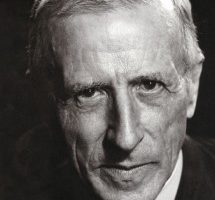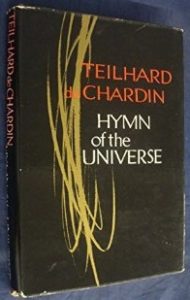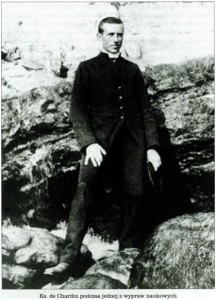An earlier version of this article appeared in Contemplative Journal
Writing forty-eight years ago, Roman Catholic Archbishop Fulton Sheen predicted, “It is very likely that within fifty years when all the trivial, verbose disputes about the meaning of Teilhard’s ‘unfortunate’ vocabulary will have died away or have taken a secondary place, Teilhard will appear like John of the Cross and St. Teresa of Avila, as the spiritual genius of the twentieth century.”

Following the same trajectory of sight, earlier this month my own friend and teacher Cynthia Bourgeault declared 2015 “The Year of Teilhard de Chardin,” and challenged her network of students in the Christian Wisdom tradition to begin working their way through his corpus.
She wrote: “Teilhard’s star is now rising powerfully on the horizon, heralding the dawn of an entirely new kind of Christian theology. […H]e is finally coming into his own as the most extraordinary mystical genius of our century and the linchpin connecting scientific cosmology and Christian mystical experience on a dynamic new evolutionary ground.”
Archbishop Sheen’s “fifty years” are almost up, and certainly his words seem to have been prophetic. For those of you who don’t know him, Pierre Teilhard de Chardin was a French Jesuit and paleontologist who lived from 1881-1955. Largely silenced by the Vatican during his lifetime, today Christian thinkers are beginning to discover how vital his voice and vision are for a Christianity that will have any serious traction in the 21st century. My own sense is that this is because Teilhard—unlike any thinker before him—united in a single vision devotional fire, mystical depth, scientific and evolutionary thought, and Christian faith.
He brings these various strands of truth together in a way that each strengthens and supports the other, each coming into its own hidden fullness through the encounter. Not only does Christian mystical hope take on deeper resonance and meaning in light Teilhard’s scientific and evolutionary thought, but evolution’s processes and trajectory become clear and focused in light of his mysticism. Once the synthesis has been achieved, the connections seen, they can never be unseen. Today, the number of seers is reaching a critical mass.
My own encounter with Teilhard began six years ago, of all places, in India. I was staying near an ashram dedicated to the nondual teachings of Advaita Vedanta, and struggling with what seemed to be the other-worldly emphasis of this tradition: You are not the body. The world is illusion. I was convinced that Advaita had realized a significant truth, but I was also confident that this couldn’t be the whole picture—that our manifestation in this world of form and duality was profoundly important. One morning, wrestling with this tension, I hiked to the top of the sacred hill where the ashram sat, listening to a lone monk chant his morning prayers along the way. The whole time I felt a profound unease with what seemed like a disembodied spirituality.
When I reached the top, something prompted me to walk back down the mountain a different way. I found myself arriving right smack in the middle of town, surrounded by the colors, sounds, and smells of the market, children playing, an elephant in the temple courtyard, everything bursting with life. I felt an overwhelming sense that this was where God was happening, that God had poured God’s self out into matter, as matter, in order to be known through the beauty and diversity of creation. The goal of life could not be simply escape or the realization that the world was illusion.
I made my way back to the ashram, to the quiet side of the mountain, and wandered into the library, looking for a book. I was certainly not looking for a Christian book. Something on Hinduism, maybe Buddhism. But my eye, almost against my will, fell on a title along a spine that read Hymn of the Universe by Teilhard de Chardin. I pulled the book off the shelf, read the first few words, and my whole being glowed with recognition. I devoured the first section, The Mass on the World.
eye, almost against my will, fell on a title along a spine that read Hymn of the Universe by Teilhard de Chardin. I pulled the book off the shelf, read the first few words, and my whole being glowed with recognition. I devoured the first section, The Mass on the World.
Finding himself in the steppes of China without bread or wine or altar to celebrate the Mass, Teilhard wrote: “I will raise myself beyond these symbols, up to the pure majesty of the real itself; I, your priest, will make the whole earth my altar and on it will offer you all the labours and sufferings of the world.” He prayed, “Over every living thing which is to spring up, to grow, to flower, to ripen during this day say again the words: This is my Body.” I saw the spices and fresh fruit in the market, the elephant at the temple, the children playing.
He sang: “For me, my God, all joy and all achievement, the very purpose of my being and all my love of life, all depend on this one basic vision of the union between yourself and the universe. Let others, fulfilling a function more august than mine, proclaim your splendours as pure Spirit; […] I have no desire, I have no ability, to proclaim anything except the innumerable prolongations of your incarnate Being in the world of matter; I can preach only the mystery of your flesh…” Matter was not a distraction from God, but the very outworking of the life of God in form: a cosmic Incarnation.
Reading Teilhard’s words, my heart sang with his. What I found in his Hymn was a profound spiritual love of matter, of body and form; it was the balance I so desperately needed to complement the teachings of Advaita. This was not a nonduality that said “The world is illusion” or “You are not the body.” This was a nonduality that said, “You are the body of God.” Teilhard struck right at the heart of a tension felt by spiritual seekers throughout history, and one that I was certainly feeling: a pull between a spirituality that is all about swimming back “upstream” to a rarefied, nondual awakening (with little relation to the world and the body), and a spirituality that is about fully embracing life in form, duality and diversity.
Teilhard felt this tension in himself between the classical mystical pull towards the “Absolute” and his deep love for matter and the Earth, and he found that these seemingly contradictory “upward” and “downward” currents could be reconciled and united in a forward movement: that of an evolving universe. In a static universe (or worse, as some traditions have it, a degenerative universe), it makes perfect sense that the goal of the spiritual journey is to swim back “upstream” to God. But in an evolving and converging universe, the goal shifts dramatically: our spiritual work is not about escape, but instead about driving the whole creation forward toward that which is becoming.
the Earth, and he found that these seemingly contradictory “upward” and “downward” currents could be reconciled and united in a forward movement: that of an evolving universe. In a static universe (or worse, as some traditions have it, a degenerative universe), it makes perfect sense that the goal of the spiritual journey is to swim back “upstream” to God. But in an evolving and converging universe, the goal shifts dramatically: our spiritual work is not about escape, but instead about driving the whole creation forward toward that which is becoming.
Teilhard saw this forward movement at the heart of the Christian doctrine of the Incarnation—God becoming flesh and form in Jesus of Nazareth. The Incarnation, however, was not an isolated, one-time event, but rather an ongoing process, carried forward uniquely in each human being. In Teilhard’s words: “each of us is our own little microcosm in which the Incarnation is wrought independently with degrees of intensity and shades that are incommunicable.” Each instance of Incarnation, however, while unique, is not discrete, but part of a single, vast unfolding, initiated in Jesus and continuing as an awakening and expanding collectivity: an organic, growing Body of Christ. “Christ,” Teilhard wrote, “is not yet fully formed: he has not yet gathered about him the last folds of his robe of flesh and of love…” In this light, Christianity becomes not simply a path of ascent or return to God, but a path flowing out from God, as God flows more and more fully into form.
While the New Testament authors could not have framed this movement in evolutionary terms, Teilhard found in them a profound sense of the forward momentum that drove his own vision. St. Paul spoke of the whole creation “groaning in labor pains” as it worked to bring forth something new and glorious, “the revealing of the children of God” (Romans 8:19-22). Teilhard stepped in and connected the evolutionary dots. Charting the course of evolution, he saw the development of a geosphere (the planet), a biosphere (organic life), and finally the emergence of what he called the noosphere—from the Greek nous, or mind—a sphere of conscious awareness, which finds its greatest outlet and expression in humanity.
For Teilhard, the next phase of evolution would be primarily within the noosphere, and it was here that he located the work of Christ: the initiation of a new phylum of love within the consciousness of the planet, unfolding as the deepening Incarnation of God. He wrote: “Someday, after mastering the winds, the waves, the tides and gravity, we shall harness for God the energies of love, and then, for a second time in the history of the world, humankind will have discovered fire.” These energies of love, this fire, Teilhard believed, would drive the noosphere into its next evolutionary leap: the “christification” of the human species.
For Teilhard, the whole movement was towards a convergence on what he called “Christ-Omega” or the “Omega Point.” The deeply personal, intimate, nondual center of the universe, what Teilhard called the “Heart of God”—revealed for him in the life of Jesus—was also the point of convergence towards which the whole planet was moving. Again, he turned to the words of St. Paul: “With all wisdom and insight God has made known to us the mystery of God’s will, […] a plan for the fullness of time, to gather up all things in Christ, things in heaven and things on earth” (Eph. 1:8-10): a convergence of spheres, a coincidence of opposites, the union of the human and divine in the unfolding Body of Christ. This convergence he identified with what has traditionally been called the “Second Coming of Christ”—Christ’s coming in fullness and glory through the noosphere of the planet.
Today we might identify this next evolutionary phase as the emergence of “nondual consciousness” at increasing levels within the noosphere: a deepening, lived awareness of the profound unity at the heart of existence. This will not, however, be a dissolution out of matter and back into a pre-existent unity, but a movement forward, towards something new: an ultimately global expression of conscious unity in matter. Teilhard saw that for the first time in planetary history, evolution (heretofore operating unconsciously) had become conscious of itself in and through the human species. Now evolution is ours to guide, and our conscious efforts to advance the growing phylum of love within the life of our planet will determine our future.
Teilhard wrote towards the end of his life, “I can see quite clearly that the reason I can have influence does not come at all from what I have ‘invented,’ whatever that may be, but simply from the fact that I have found myself ‘resonating’ in the right way to a certain vibration, a certain human and religious note, which is now in the air everywhere.” During this Year of Teilhard de Chardin, we are being invited to move into this resonance, to further the growing phylum of love, to join this great apostle of the Incarnate God in the work of evolving our human family and our planet.
Teilhard states in the boldest terms what our work in this great work is: “it is no longer a matter of simply seeing God and allowing oneself to be enveloped and penetrated by God—we have to do more: we have to disclose God (or even in one sense of the word ‘complete’ God) ever more fully.” For Teilhard, each of our lives is potentially a deepening of the disclosure and a completing of the Incarnation of God. We serve—and become—this disclosure through the evolutionary energies of love. Teilhard knew that to arrive at the fullness of this work would take time, and looking back at the long history of cosmic and planetary evolution, that this time could be long. But he was not one to lose hope. Our current global crises he saw, not as signs of the end, but as the birth pains of a new beginning.
“Above all,” Teilhard wrote, “trust in the slow work of God. We are quite naturally impatient in everything to reach the end without delay. We would like to skip the intermediate stages. We are impatient of being on the way to something unknown, something new. And yet, it is the law of all progress that it is made by passing through some stage of instability—and that it may take a very long time. Above all, trust in the slow work of God.”
And so I pray: May we not only trust, but join in, the slow work of God, and may the deepening Incarnation of the Heart of God, through us, flow into form. Amen.

In a recent book I was reading the word “Amen” was used, but in its Aramaic form “Ameyn”, which was translated “This is the ground of my connection with Unity, from which all my actions will flow.”
And to your essay, Matthew, I say AMEYN!
Dear Richard,
Thanks for your comment. I’ve admired Contemplative Fire from a distance for a few years now. I’d love to visit the community sometime–which would be easier if there wasn’t an ocean between us! But I’m so encouraged by the kind of ministry and vision happening there.
Glad to reconnect you with Teilhard. I’ll look up the Laloux book.
Thanks and blessings,
Matthew
Thank you for reminding me about Teilhard. I last read him 50 years ago! I shall now return to him. I got the link to you through Contemplative Fire, a Wisdom community here in the UK – part of the emergence of the non-dual consciousness. It comes in a week in which I have been excited by more evidence of this next stage in the evolution: Frederick Laloux’s book, Reinventing Organisations, which shows how some organisations, both non profit making and for profit are embodying the emergent consciousness.
Richard Craig